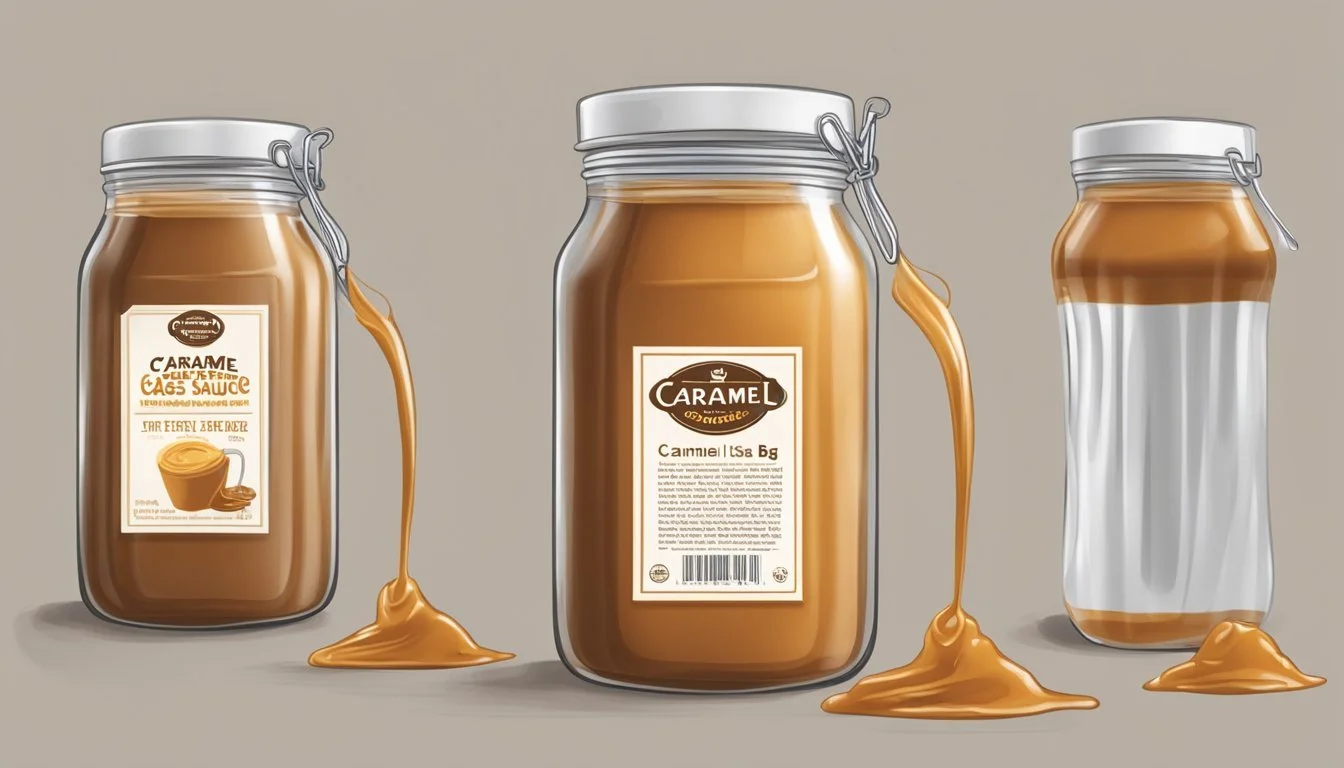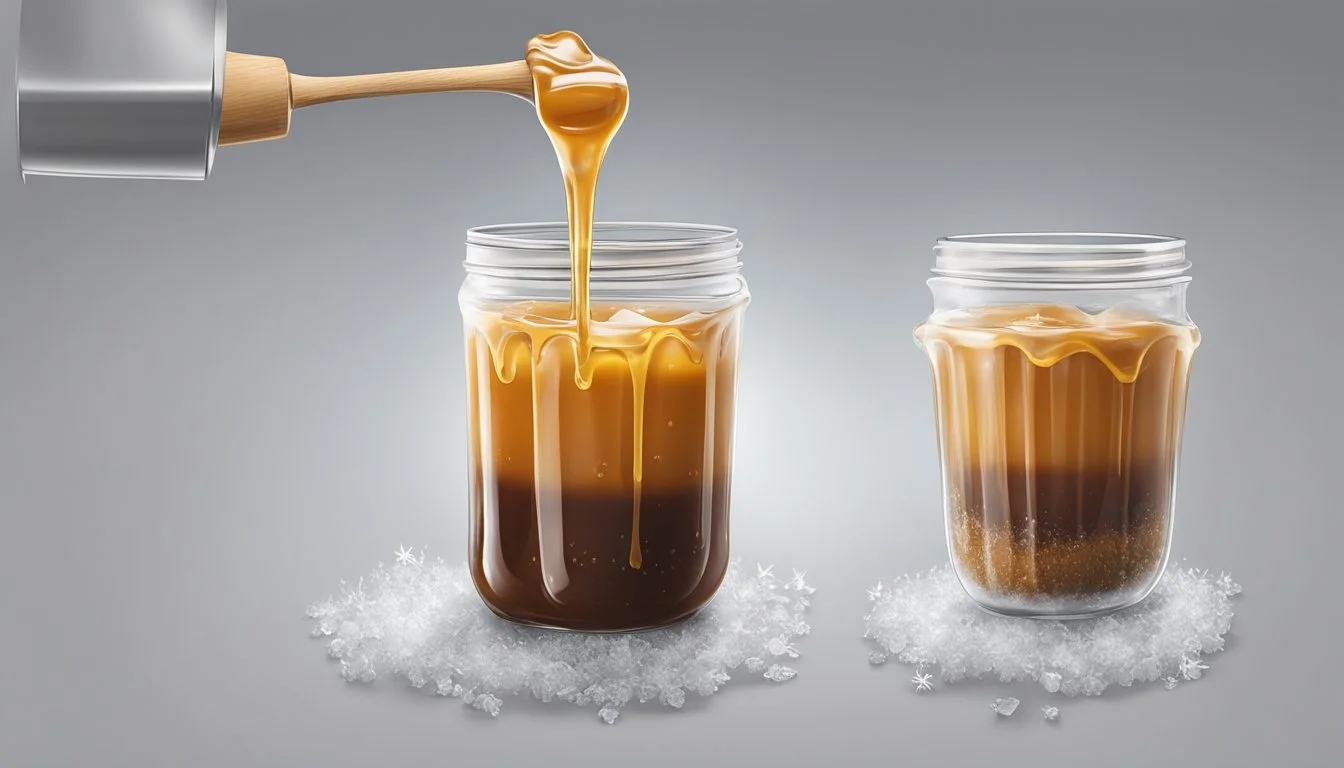How to Freeze Caramel Sauce for Decadent Desserts
A Step-by-Step Guide
Caramel sauce is the crowning glory of many desserts (What wine goes well with desserts?), providing a rich, buttery sweetness that can elevate a simple ice cream scoop to an indulgent treat. Not only does it pair wonderfully with an array of desserts, from cakes to pies, but its smooth texture and deep flavor also make it a versatile ingredient for creative confectioners. The ability to freeze caramel sauce successfully means that one can have this delicious topping on hand at all times, ready to be defrosted and drizzled over the dessert of their choosing.
The process of freezing caramel sauce is straightforward, ensuring that its quality and flavor remain intact when thawed. This opens up the possibility of making larger batches without concern for immediate consumption or waste. One can store caramel sauce in the freezer for several months, maintaining its delectable flavor profile, which includes notes of vanilla and a subtle hint of salt that helps balance the sweetness.
Understanding the right way to freeze, defrost, and store caramel sauce is essential for any dessert enthusiast or home cook who aspires to have this luscious condiment readily available. A properly frozen caramel sauce retains its velvety texture and does not separate or crystallize, which is key to preserving its quality. Thawing it correctly is just as important to ensure a smooth consistency, ready for enhancing the next dessert masterpiece.
The Basics of Caramel Sauce
Caramel sauce is a rich, sweet condiment made with a blend of sugar, butter, cream, and often vanilla and salt. Its velvety texture and complex flavor make it a versatile topping for many desserts.
Understanding Caramel Ingredients
Ingredients:
Granulated Sugar: The foundation of caramel sauce, responsible for the rich sweetness and color.
Butter: Adds a creamy texture and depth of flavor.
Heavy Cream: Contributes to the silky consistency.
Vanilla Extract: Enhances the sauce's aroma and flavor complexity.
Kosher Salt: Balances the sweetness and enhances the overall taste.
When these ingredients are combined and cooked to the right temperature, they create the classic sauce cherished for its flavor and appeal.
Caramel Sauce Preparation Techniques
To prepare homemade caramel sauce, here is a simplified process:
Combine Sugar and Water: In a saucepan, dissolve granulated sugar in water and heat over medium-low to produce a consistent sugar syrup.
Boil to Amber: Heat the mixture until it reaches a boil and continues boiling until the syrup turns an amber hue, typically needing no candy thermometer.
Add Cream and Butter: Carefully stir in the butter and heavy cream, taking care as the mixture will bubble and steam.
Simmer: Return the mixture to the heat and let it simmer until it thickens to the desired consistency.
Season: Add salt and vanilla extract to taste, stirring them into the sauce thoroughly.
It's important to cook the caramel on a steady medium-low heat to avoid burning the sugar. Calories and nutrition vary, with caramel sauce generally being high in sugar and fat.
Packaging for Freezing
When freezing caramel sauce, proper packaging is crucial to maintain its quality and prevent freezer burn. The right container ensures the sauce stays delicious and ready for future indulgent desserts.
Choosing the Right Container
The ideal container for freezing caramel sauce should be airtight to preserve the sauce's texture and flavor. Freezer-safe plastic containers and Ziploc bags are suitable choices as they can withstand low temperatures without cracking and are less likely to form ice crystals inside. Glass containers are generally not recommended due to the risk of breakage as the sauce expands during freezing. If one opts for a glass container, ensuring it's designed for freezer use and leaving ample headspace to accommodate expansion is necessary.
Preparing the Sauce for Freezing
Before packaging, the caramel sauce should be cooled to room temperature. Filling an airtight container, leave about a half-inch of headspace at the top to allow for expansion as the sauce freezes. Ensure the lid is sealed tightly to protect against freeze burn and odor absorption from other freezer items.
Labeling and Storage Recommendations
After the caramel sauce is properly packed, labeling each package with the contents and date of freezing is important for organization and rotation purposes. This helps keep track of how long the caramel sauce has been stored. For best quality, it's recommended to use the frozen caramel sauce within three to six months, although it remains safe to consume beyond this period. When storing in the freezer, place the packages in a location where they are less likely to be subjected to frequent temperature changes, such as the back of the freezer rather than near the door.
Freezing and Thawing Methods
Before indulging in the rich flavor of caramel sauce, it's important to understand the proper techniques for preservation and revival. Effective freezing and thawing methods are crucial to maintain the sauce’s quality and texture.
Proper Freezing Techniques
To freeze caramel sauce:
Cool Completely: Ensure the caramel sauce is at room temperature before freezing to prevent crystallization.
Portion Control: Divide the sauce into smaller quantities using ice cube trays or small containers. This makes it convenient to thaw only what you need later.
Airtight Containers: Transfer the sauce to airtight containers or heavy-duty freezer bags. Seal tightly to avoid exposure to air, which can cause freezer burn.
Label and Date: Clearly label each container with the contents and the date frozen. Caramel sauce can be stored in the freezer for up to one year without a significant change in texture.
Thawing and Reheating Caramel Sauce
To thaw and reheat caramel sauce:
Refrigerate: For gradual thawing, move the frozen caramel sauce to the refrigerator overnight. This slow process helps maintain the sauce’s texture.
Room Temperature: If time permits, allowing the sauce to come to room temperature on the countertop is another gentle method.
Microwave: For a quicker option, place the caramel sauce in a microwave-safe dish. Thaw at half power in 30-second intervals, stirring well each time to ensure even reheating.
Double Boiler: Alternatively, one can reheat the sauce using a double boiler on the stove. Place the caramel sauce in a heat-safe bowl over a pot of simmering water. Stir continuously until it reaches the desired consistency and temperature.
Freezing and thawing caramel sauce correctly will make it easy to enjoy your dessert at a moment's notice.
Incorporating Caramel Sauce into Desserts
Caramel sauce enhances desserts by adding a silky, rich layer of flavor. It pairs well with various sweet and savory elements, offering a balance to desserts with its buttery and sometimes salty profile.
Decadent Dessert Ideas with Caramel Sauce
Ice Cream & Frozen Treats: A generous drizzle of caramel sauce over vanilla ice cream or added to a milkshake provides a classic flavor combination. Swirl it into homemade ice cream before freezing for a marbled effect.
Cakes & Brownies: Layer caramel sauce in cakes or brownies, ensuring each bite has a gooey texture. It complements chocolate and vanilla bases alike.
Fruit Dips & Toppings: Caramel apple dip is a delightful treat; simply mix caramel sauce with a touch of sea salt. It pairs beautifully with sliced apples, pears, or bananas.
Pastries & Breads: Drizzle caramel sauce over cinnamon rolls or apple pie for a lush finish. Stir a spoonful into coffee or hot chocolate for a sweet twist.
Pairing and Serving Suggestions
Flavor Combinations: Salt enhances the complex flavors of caramel. Consider adding a pinch of sea salt or using salted butter in the caramel sauce recipe for a salted caramel variation.
Textures & Temperatures: For a contrasting experience, serve warm caramel sauce with cold desserts like ice cream. The sauce can also coat popcorn and nuts for a crunchy indulgence.
Creative Uses: Explore beyond traditional desserts by incorporating caramel into candy, using it as a filling for cookies, or as a swirl in cheesecake. Remember, balance is key; pair the sweet caramel with less sweet desserts or a dash of cinnamon, vanilla extract, or espresso to break the sweetness.
Additional Tips and Tricks
For individuals passionate about preserving the lush flavor and smooth texture of homemade caramel sauce, a few strategic practices can be the difference between success and disappointment in freezing this dessert adornment.
Ensuring Optimal Flavor and Texture
To maintain the decadent flavor and silky texture of caramel sauce after freezing, one should first cool the sauce to room temperature before sealing it in an airtight container. This prevents ice crystal formation, which can lead to crystallization and affect the sauce’s consistency upon thawing. For best results, one should thaw the caramel sauce slowly in the refrigerator rather than using a microwave, which can unevenly heat and alter the delicate balance of flavor and texture.
Freezing Tips:
Cool down: Ensure caramel sauce is at room temperature.
Airtight sealing: Use containers that seal out air.
Gradual thaw: Refrigerate caramel sauce to naturally thaw.
Customizing Your Caramel Sauce
Before freezing, one may wish to customize their caramel sauce for future use in various desserts. Ingredients like sea salt, cinammon, or vanilla extract can be added to the basic recipe of sugar, heavy cream, and unsalted butter. Adjusting these ingredients can tune the caramel's flavor profile from simply sweet to complexly enticing. To infuse caramel sauce with a personal twist, combine additives like coconut milk or honey for an alternative to traditional dairy or sweeten with brown sugar for a deeper, molasses-like undertone.
Customization Ideas:
Infuse unique flavors: Examine adding ingredients such as cinnamon or vanilla for subtle flavor changes.
Consider alternatives: For a different take on the classic, swap in coconut milk or honey in place of dairy products or sugar.





